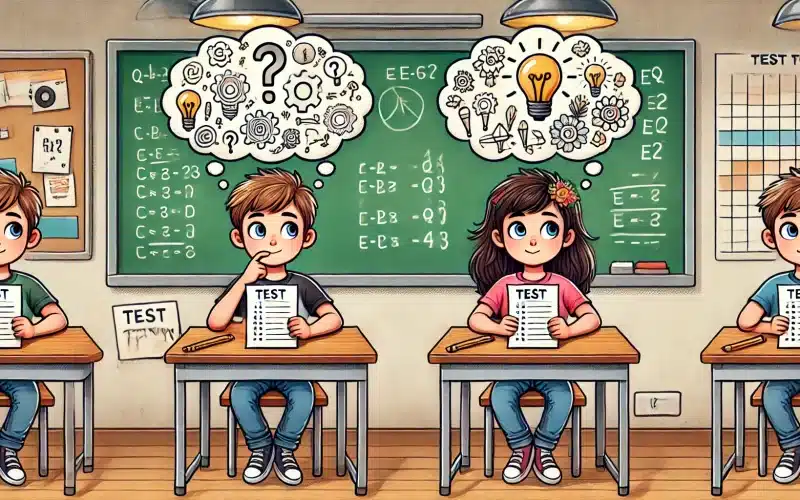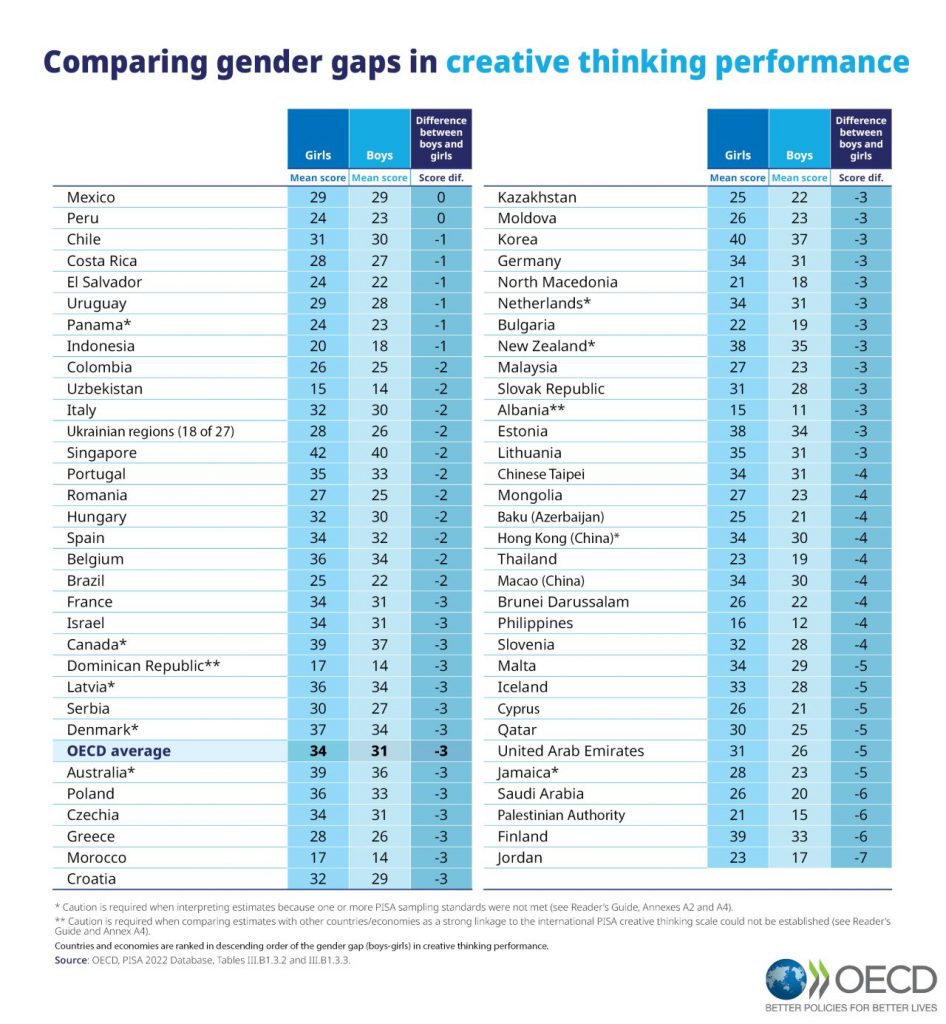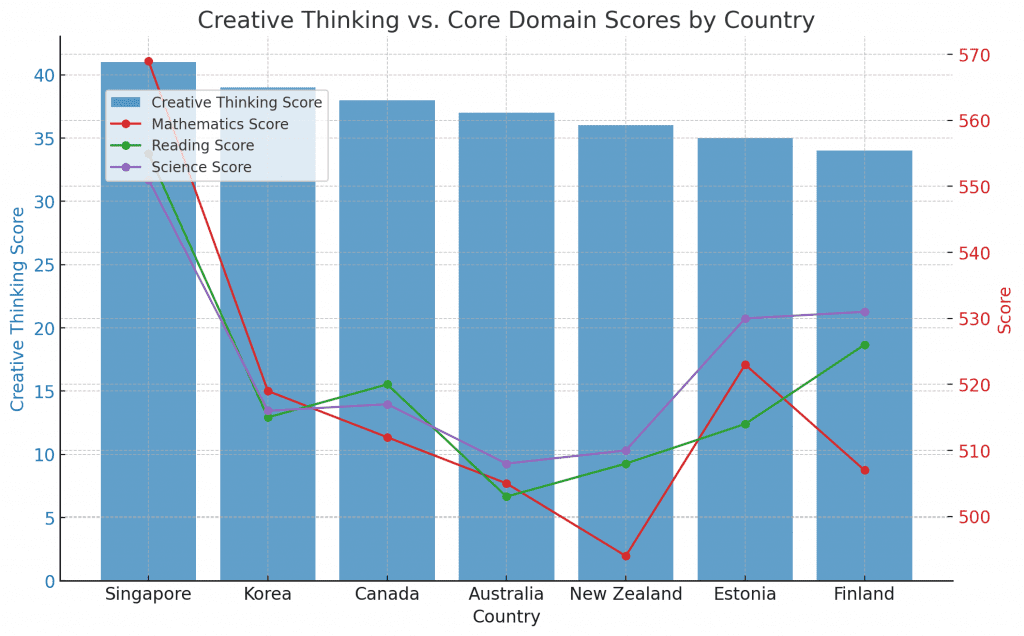
In an era still reeling from the impacts of the COVID-19 pandemic, the Programme for International Student Assessment (PISA) 2022 report sheds light on the creative thinking abilities of 15-year-old students across the globe. Nearly 700,000 students from 81 OECD member and partner economies participated in this landmark study, which marks the first large-scale assessment of student performance, well-being, and equity both before and after the pandemic disruptions.
Singapore, Korea, Canada*, Australia*, New Zealand*, Estonia, and Finland were the top performers among the 64 countries. Results revealed that students in high-performing education systems excel not only in mathematics, reading, and science but also in creative thinking. However, students from disadvantaged backgrounds and under-resourced schools scored significantly lower in creative thinking tasks.
A significant gender gap was observed, with girls outperforming boys in all types of creative thinking tasks. This difference remained significant even after accounting for performance in reading and mathematics. Girls demonstrated higher proficiency in visual and written expression, social problem-solving, and scientific problem-solving.
However, the report also shows that there is an unprecedented decline in performance across OECD countries.
Measuring Creative Thinking
For the first time, PISA 2022 has assessed the creative thinking skills of students, focusing on their ability to generate, evaluate, and improve ideas. Creative thinking is defined as the competence to engage productively in generating novel and effective solutions, advancing knowledge, and expressing imagination. The study emphasizes the importance of creativity in education for fostering innovation, problem-solving, and holistic development.
Gender Differences in Creative Performance
A standout finding from the report is indeed that girls significantly outperform boys in most creative tasks. These tasks include visual and written expression, social problem-solving, and scientific problem-solving.
Below are the results as found in the report.

Visual and Written Expression
In tasks that involved visual and written creativity, girls demonstrated higher proficiency in coming up with diverse and original ideas. This could be due to societal encouragement of expressive and communicative skills in girls from a young age, as well as educational approaches that favor detailed and imaginative writing and art.
Social Problem-Solving
Girls also outperformed boys in social problem-solving tasks, which require understanding different perspectives and finding innovative solutions to societal issues. This might be attributed to girls’ higher empathy levels and better interpersonal communication skills, which are often nurtured through both socialization and schooling.
Scientific Problem-Solving
In scientific problem-solving, girls again showed superior creative thinking. They were more adept at generating hypotheses and designing experiments, which could be linked to increasing participation and encouragement of girls in STEM (Science, Technology, Engineering, Mathematics) fields.
The reasons behind these differences could be multifaceted, involving a combination of biological, psychological, and social factors. Educational systems and cultural practices that foster creativity in girls might also play a significant role.
Below is a diagram showing the creative thinking scores alongside core domain scores (mathematics, reading, and science) for the top-performing countries in the PISA 2022 report.

Impact of COVID-19 on Education Systems
The 2022 PISA assessment is crucial as it is the first to capture data on student performance in the wake of the COVID-19 pandemic. Despite the challenges, 31 countries and economies managed to maintain their performance levels in mathematics since PISA 2018. Notably, Australia, Japan, Korea, Singapore, and Switzerland have either maintained or improved their high performance, thanks to shorter school closures, effective remote learning strategies, and strong support from teachers and parents.
Progress in Universal Secondary Education
The report highlights significant progress in expanding access to secondary education, particularly in countries like Cambodia, Colombia, Costa Rica, Indonesia, Morocco, Paraguay, and Romania. These nations have successfully broadened educational opportunities to previously marginalized populations, promoting equality and economic participation.
Decline in Performance and Socioeconomic Equity
However, the PISA 2022 assessment reveals an unprecedented decline in performance across OECD countries. Compared to 2018, the average scores dropped by ten points in reading and nearly 15 points in mathematics, equating to three-quarters of a year’s worth of learning. This decline is more pronounced in 18 countries and economies where over 60% of 15-year-olds are falling behind.
The Role of Technology and Teacher Support
The pandemic-induced shift to remote learning highlighted the importance of digital literacy. On average, students who used digital devices for learning scored higher in mathematics, but excessive use of technology for leisure was associated with poorer results. Teacher support emerged as a critical factor, with students reporting higher mathematics scores where teachers were readily available to help.
Parental Engagement and Investment in Education
Parental engagement also plays a significant role in student performance. Education systems that saw increased parental involvement between 2018 and 2022 showed greater stability or improvement in mathematics performance. Additionally, the report finds a positive correlation between educational investment and performance up to a certain threshold, emphasizing the need for targeted funding to improve educational outcomes.
Discover More About PISA 2022 Findings
For a detailed exploration of the PISA 2022 results and their implications, visit the OECD website. The full report offers comprehensive data and analysis.
